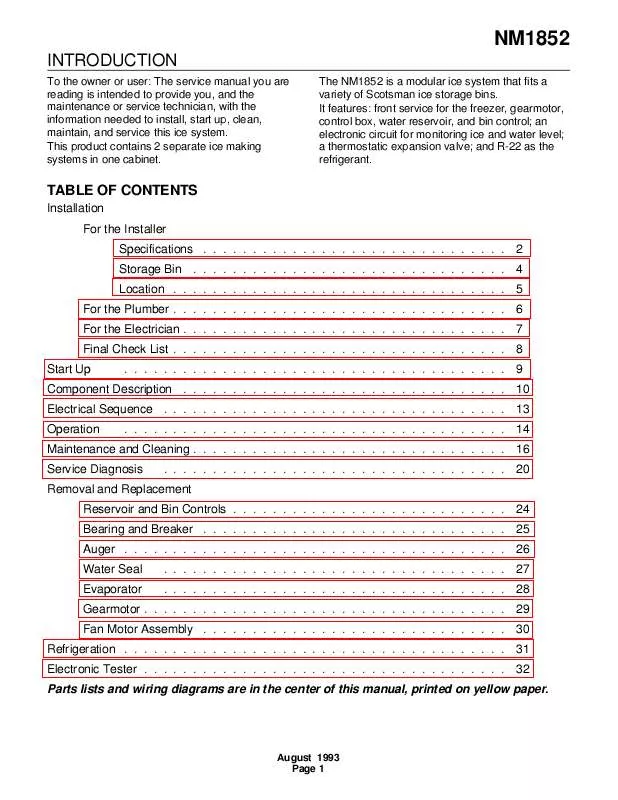Detailed instructions for use are in the User's Guide.
[. . . ] NM1852
INTRODUCTION
To the owner or user: The service manual you are reading is intended to provide you, and the maintenance or service technician, with the information needed to install, start up, clean, maintain, and service this ice system. This product contains 2 separate ice making systems in one cabinet. The NM1852 is a modular ice system that fits a variety of Scotsman ice storage bins. It features: front service for the freezer, gearmotor, control box, water reservoir, and bin control; an electronic circuit for monitoring ice and water level; a thermostatic expansion valve; and R-22 as the refrigerant.
TABLE OF CONTENTS
Installation For the Installer Specifications . [. . . ] Check: Voltage to the unit, restore it if there is none. Check: The master switch, switch ON if off. Check: The 3 reset switches, (spout switch, high and low pressure): depress and release each switch. If the still does not start, check: the spout switch; the high and the low side pressures. Check the low pressure cut out, if closed, go to E; if it is open, it could be due to:
· Low refrigerant charge · The auger not turning · Restricted system · TXV not opening
1. Check the low side pressure, the low pressure cut out opens at pressure below 4 psig. Check if the auger is turning, if it is not, remove the gearbox and: Check for internal damage, repair and replace in the machine. Check for low charge, add some refrigerant, if the unit will operate, (normal low side pressure being about 25 psig) stop and look for a leak, recover, repair, replace the drier, evacuate, and weigh in the nameplate charge. If, with added charge, the unit does not operate: Check for a restricted system, replace the drier, evacuate, and weigh in a nameplate charge. Check for a Thermostatic Expansion Valve that does not open, if defective, replace it. Replace the drier, evacuate, and weigh in the nameplate charge.
E. Check the high pressure cut out, if closed, go to F; if open check: 1. Check the high side pressure, reset the control, and observe: on water cooled, that water soon begins to flow from the condenser drain; or, on air cooled, that the fan is forcing air through the condenser. If the unit trips out on pressures below 400 psig, replace the control. If the pressures rise above the trip out point, and the unit shuts down: a. Check for adequate water flow on water cooled, if adequate, clean the interior of the condenser. If the pressures are still too high replace the water regulating valve. Check for adequate air flow on air cooled. Clean the condenser and (if used) the filter. If the air flow is poor because of the installation, advise the user that the unit should be moved, or the air around it kept cooler. Check the fan motor for tight bearings and proper rotation. Check that the fan blades are clean, and the fan secure to the fan motor shaft. [. . . ] The low side pressure is much more important on an ice machine than is the high side.
· If gauges must be used, use very short hoses.
Minimal refrigerant discharged into the hoses equals minimal refrigerant discharged into the air. If using recycled refrigerant, it must meet ARI spec 700-88 or have been cleaned by a machine capable of attaining ARI spec 700-88.
· Refrigerant should not be added except as a
way to determine the proper operation of the product. If the system was low on refrigerant, there is a leak, and it must be found and repaired.
· Refrigerant must not be vented to the
atmosphere.
· This system has a critical charge, it must be
recharged with the correct amount of refrigerant as listed on the nameplate of the ice machine, or performance will suffer.
· Anytime the refrigeration system has been
opened, the dryer should be replaced.
· When brazing the tubing connections to the hot
gas or thermostatic expansion valve, the component must be protected by heat sink material.
August 1993 Page 31
NM1852
CIRCUIT BOARD TESTING
WARNING These procedures require the machine to be connected to the power supply. The voltages of the electronic circuit are very low, but HIGHER VOLTAGES ARE PRESENT IN THE UNIT. [. . . ]


